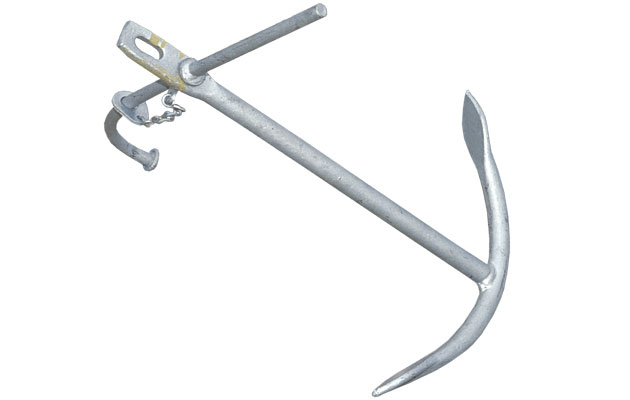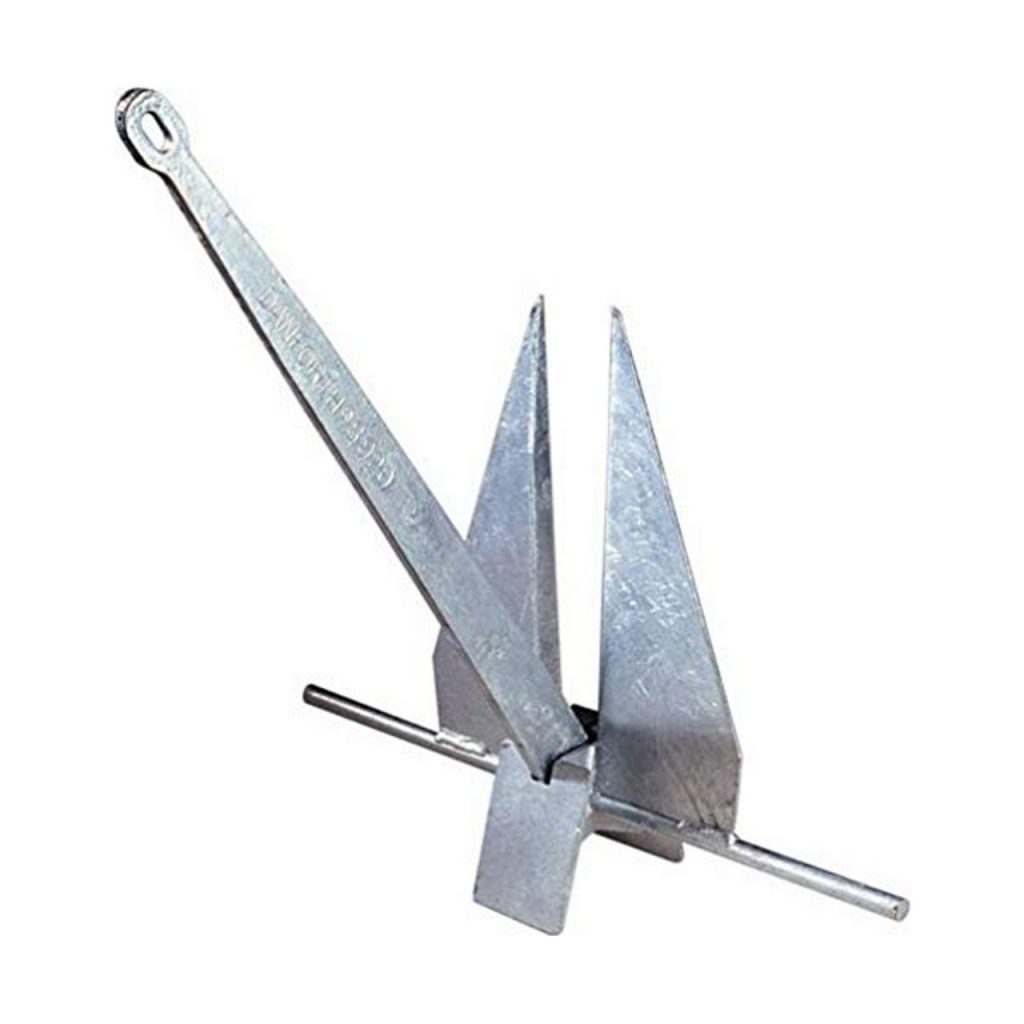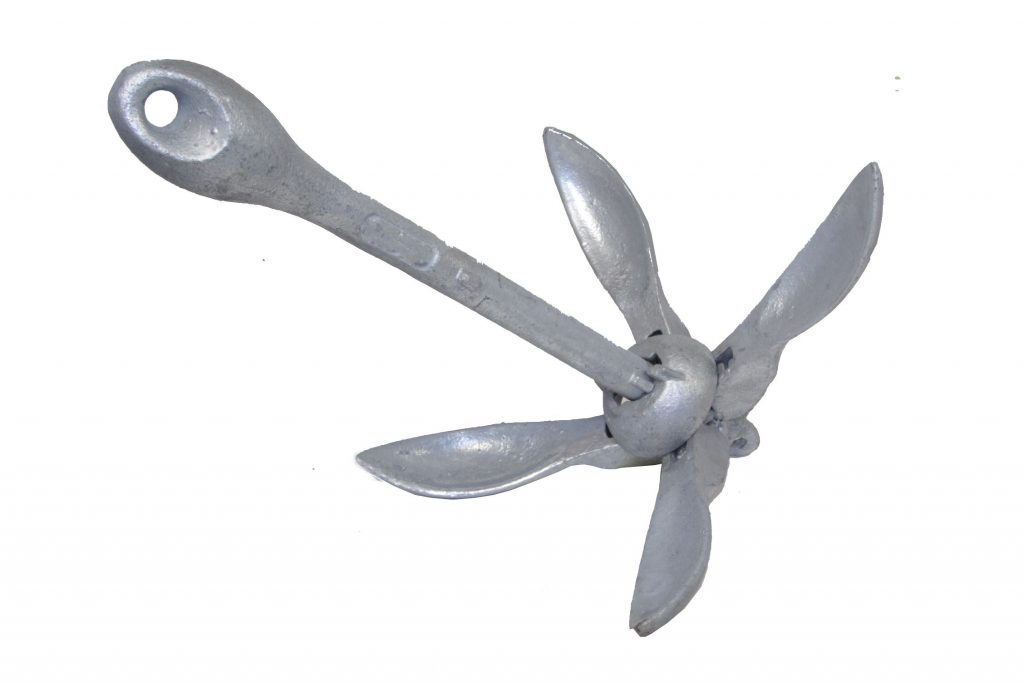It depends on the size of your boat and where you anchor.Below I have listed several scenarios that each require the use of different anchors.
The anchors we commonly use are Hall anchor, Bruce Anchor, Plough Anchor, Fisherman Anchor, Danforth Anchor, Grapnel Anchor, Spade Anchor.Read on and I will tell you the difference.
Hall Anchor

A Hall anchor is a commonly used conventional stockless anchor found throughout the commercial shipping industry. The traditional design and proven performance makes the Hall anchor an attractive anchor for your ship. The Hall anchor is stowed against the shell or frog eye.
Bruce Anchor

The Bruce anchor is an excellent all-purpose anchor as it performs well in most sea bottoms including mud, sand, rock, and coral. It has a harder time penetrating harder surfaces, such as clay, and bottoms with heavy grass. The three-claw design sets more easily than other anchors.
Plough Anchor

Generally speaking, the most versatile anchors are the plough anchor. They will provide good holding in mud, sand and gravel. In large rocks, they can skid around or jam tight.
Fisherman Anchor

The Fisherman anchor holds well on rock and weed, but its tiny flukes are likely to drag on any other bottom, ruling it out in most anchorages. Fishermen anchor where the fish are, over reefs and rocky outcrops.
Danforth Anchor

If space is tight on your boat, a Danforth / flat anchor is good to have. They will provide good holding on soft bottoms until the tide changes. It’s a good second anchor to carry as a kedge.(You’ll really appreciate that kedge anchor when you run aground on a lee shore and are frantically rowing your dinghy seaward to drop an anchor and pull your boat off before the ebb sets in. )
Grapnel Anchor

A folding grapnel anchor is all you need for a dinghy or small runabout, if you just want to take a breather for an hour or two.
Spade Anchor

A spade or Bügel anchor provides a good holding-to-weight ratio and is a rock-solid piece of kit. It’s a nice simple design. Makes a good (possibly better) alternative to a plough.
There are lots of variations on these patterns.
Conclusion abou What is the Best Type of Anchor
Hall anchor: The Hall anchor is a traditional type of boat anchor that features a central shank with flukes at the ends. It is known for its strong holding power in various seabed conditions and is commonly used for larger vessels and in offshore applications.
Bruce anchor: The Bruce anchor, also known as the claw anchor, is a popular choice for boaters due to its reliable holding power. It consists of a pivoting shank with sharp curved flukes that dig into the seabed. The Bruce anchor performs well in most bottom types, making it versatile for different conditions.
Plow anchor: The plow anchor, also referred to as the CQR anchor, is designed with a single curved fluke and a pointed tip. It is recognized for its excellent holding ability in different bottoms, including sand, mud, and gravel. Plow anchors are commonly used on recreational boats and larger vessels.
Fisherman anchor: The fisherman anchor, also known as the Danforth anchor, is a lightweight and easy-to-handle option. It features two large flat triangular flukes connected to a stock at the crown. The fisherman anchor excels in sand and mud bottoms, providing reliable holding power for smaller boats.
Danforth anchor: The Danforth anchor, or the fluke anchor, is a widely used type of anchor known for its lightweight construction and excellent holding capacity. It typically consists of two sharp triangular flukes attached to a stock. The Danforth anchor is effective in sand and mud and is commonly used for recreational boats.
Grapnel anchor: The grapnel anchor is a compact and versatile anchor design commonly used in small boats and as a temporary or emergency anchor. It consists of multiple folding or articulated flukes that resemble a grappling hook. The grapnel anchor is ideal for snagging and holding on to rocks, reefs, or other structures.
Spade anchor: The spade anchor is a modern and innovative design known for its high holding power and ability to reset itself if the wind or current changes. It features a concave shape that allows it to dig deep into the seabed. Spade anchors are popular among boaters who value performance and reliability in various conditions.
FAQ abou What is the best type of Anchor
Q: Which anchor is best for sandy bottoms?
A: For sandy bottoms, anchors like the Danforth anchor, fisherman anchor, or plow anchor are often recommended. These anchors have flukes or blades that can penetrate and hold well in sandy seabeds.
Q: What anchor is suitable for rocky bottoms?
A: For rocky bottoms, a grapnel anchor or a plow anchor with a sturdy design can be effective. Grapnel anchors have multiple folding flukes that can latch onto rocks, while a robust plow anchor can resist abrasion and securely hold in rocky areas.
Q: Which anchor is ideal for muddy or soft bottoms?
A: Anchors like the Danforth anchor or plow anchor tend to work well in muddy or soft bottoms. These anchors can dig into the soft seabed and provide good holding power.
Q: What anchor should I use for offshore or strong current conditions?
A: In offshore or strong current conditions, a Hall anchor or a high-performance anchor like a spade anchor is often recommended. These anchors offer excellent holding power and can withstand strong currents and challenging conditions.
Q: Can I use the same anchor for different situations?
A: While some anchors are more versatile than others, it is generally recommended to have different types of anchors for different situations. This ensures that you have the right anchor to match the specific seabed conditions and boating requirements you may encounter.
Q:Should I use a full chain anchor rope or a combination of chain and rope?
A:You should also consider whether you want to have an all-chain anchor line or a combination of chain and rope. You should carry rope/chain for at least 10 times the depth of water you’re expecting to anchor in. So if you’re anchoring off coasts which are steep-to, in depths of around 6–8 metres, you will need to attach at least 10 metres of chain and 70 metres of rope to your anchor.
Even for a lunchtime stop in good weather, your anchor ‘scope’ (the amount of line that you pay out) will need to be at least five times the depth of water for even remotely secure holding. An anchor has to be pulling horizontally to set.
Q:Where should I buy a boat propeller?
If you need to buy a boat propeller, you can get one from VIF. They are highly recognized in North America.




